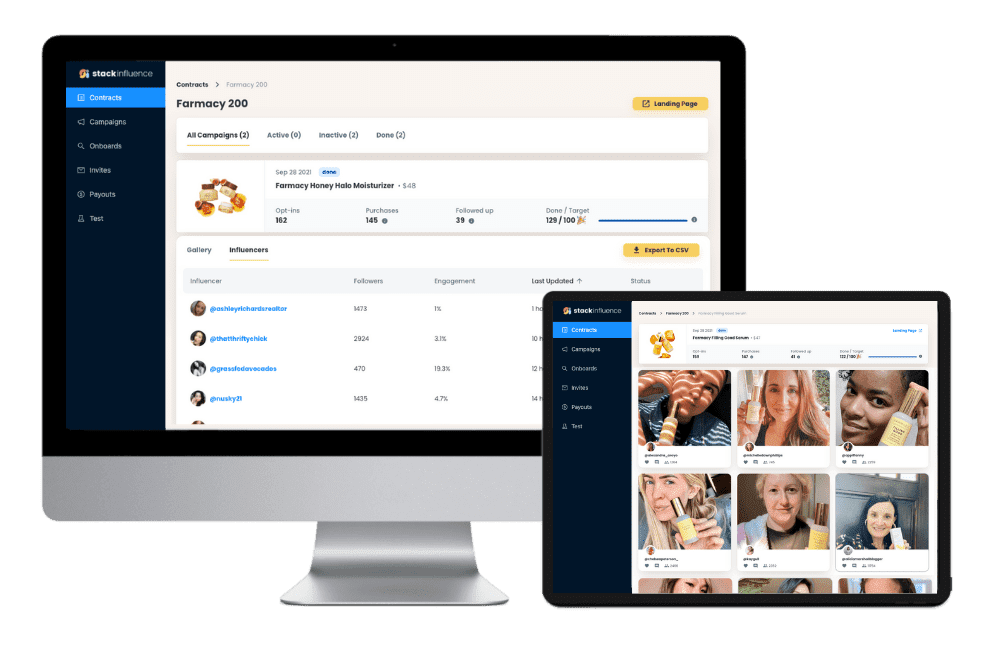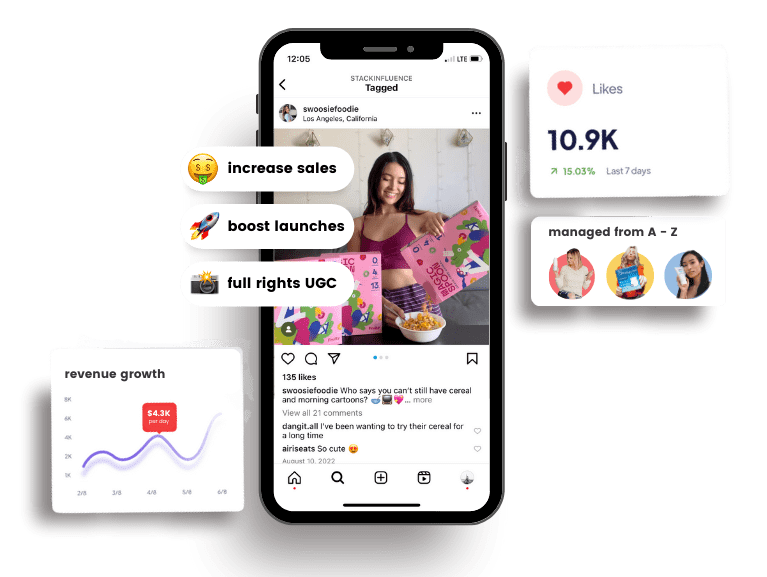Influencer Marketing vs Traditional Marketing: Which Is Best for You?
27th
October, 2025
Influencer Marketing
Amazon Marketplace
Artificial Intelligence
TikTok Tips
Influencer Marketing vs Traditional Marketing: Which is Best for You? This question has become increasingly relevant as marketing strategies evolve. In recent years, influencer marketing has surged from a niche tactic into a powerhouse $24+ billion industry (on track to reach $32.5 billion by 2025). This explosive growth – far outpacing traditional advertising sectors – reflects a fundamental shift in how brands reach consumers. But does that mean influencer campaigns are always better than old-school ads? Below, we’ll break down what influencer marketing is vs. traditional marketing, compare their pros and cons, and help you determine which approach (or mix of both) is best for your business.
Understanding Traditional Marketing
Traditional marketing refers to the classic, offline methods businesses have long used to promote products or services. This includes channels like print ads in newspapers or magazines, television and radio commercials, direct mail flyers, billboards on highways, and in-person events or sponsorships. Traditional marketing is essentially any advertising strategy that predates the digital age. It’s often considered “outbound” marketing because it broadcasts messages to broad audiences, sometimes interrupting people’s daily routines (think of a TV ad that plays mid-program).
Traditional Marketing: Strengths

Despite the rise of digital media, traditional tactics still offer some notable advantages:
-
- Wide Mass Reach: Channels like national TV, radio, or major print publications can expose your message to millions at once. This broad reach is useful for brands aiming to build general awareness across diverse or geographically spread audiences.
- Tangible Presence: Physical ads (billboards, brochures, product packaging) create a tangible, lasting impression. A glossy magazine ad or a billboard seen on daily commutes can reinforce brand recognition through repeated exposure.
- Trust and Familiarity: Traditional formats are familiar and often feel “legitimate” to consumers – especially older generations who grew up with them. Many people still trust a polished TV commercial or print ad because these formats have decades of credibility behind them. There’s a comfort in seeing a brand in traditional media, which can lend a sense of establishment.
- Message Control: With traditional ads, brands have full creative control over the content. You script the exact slogan, imagery, and tone, ensuring the message aligns perfectly with your branding. There’s no risk of an influencer ad-libbing off-script – the company dictates the narrative from start to finish.
- Wide Mass Reach: Channels like national TV, radio, or major print publications can expose your message to millions at once. This broad reach is useful for brands aiming to build general awareness across diverse or geographically spread audiences.
Traditional Marketing: Weaknesses
On the downside, traditional marketing faces several challenges in today’s environment:
-
- Limited Targeting: It’s hard to precisely target niche audiences through broad channels. A TV or radio spot reaches a lot of ears – but many won’t be interested in your product, leading to wasted impressions. You can pick a magazine or TV show that skews toward your demographic, but you still can’t fine-tune delivery the way you can with online targeting.
- High Costs: Traditional advertising often comes with hefty price tags. Printing thousands of flyers or running a nationwide TV campaign can cost tens of thousands to millions of dollars. This puts many traditional channels out of reach for small businesses. (For example, a single billboard or prime-time TV slot can dwarf an entire month’s social media budget.)
- Difficult ROI Tracking: Measuring the return on investment of a billboard or print ad is tricky. You might see sales lift after a campaign, but it’s hard to directly attribute which customers came from seeing a particular poster. Unlike digital marketing, there’s often no straightforward analytics – no click-through rate or conversion pixel – making it tough to know what truly worked. This lack of clear data can lead to uncertainty about effectiveness.
- Limited Engagement: Traditional ads are mostly one-way communications. There’s no immediate way for viewers to comment, ask questions, or share the content. In an age where consumers crave interaction, a static ad can feel impersonal and non-interactive. You also can’t easily pivot or adjust a message once it’s published (unlike a live digital campaign where you can tweak targeting or creative on the fly).
- Declining Attention: Perhaps the biggest challenge – people have gotten better at tuning out ads. Many consumers mentally switch off during TV commercials or flip past magazine ads. In fact, surveys show that 82% of people report actively ignoring online ads, and even 37% ignore ads on TV and 36% on the radio. This growing “ad blindness” means traditional media has to fight harder than ever to grab attention.
- Limited Targeting: It’s hard to precisely target niche audiences through broad channels. A TV or radio spot reaches a lot of ears – but many won’t be interested in your product, leading to wasted impressions. You can pick a magazine or TV show that skews toward your demographic, but you still can’t fine-tune delivery the way you can with online targeting.
Ultimately, traditional marketing can still build broad awareness and lend credibility, but its one-size-fits-all approach is less efficient in the digital era. It tends to be expensive, harder to target or measure, and struggles to engage modern consumers who are increasingly adept at filtering out advertising noise. This sets the stage for the rise of a more targeted approach – influencer marketing – which thrives on digital engagement and trust.

Unlock the Power of Micro Influencers and Elevate your Brand Today!

Understanding Influencer Marketing
Influencer marketing is a modern strategy built for the social media age. Instead of buying ad space directly, brands collaborate with influential content creators – individuals who have gained a dedicated following on platforms like Instagram, YouTube, TikTok, or blogs. These individuals (called influencers, or often content creators) promote the brand’s product or service to their audience, typically through content that feels more like a personal recommendation than a traditional ad. The core idea is to leverage the influencer’s credibility and relationship with their followers: if people trust and admire the creator, they are more likely to trust their endorsements.
In essence, influencer marketing is like word-of-mouth on steroids. It harnesses the age-old power of referrals (“I tried this product and loved it!”) but delivers it at scale through online networks. This approach has become incredibly popular in the past decade as consumers spend more time on social platforms and less time on print or broadcast media. From mega-celebrities with tens of millions of followers to micro-influencers with a few thousand highly engaged fans, there’s an influencer for every niche and audience size.
Influencer Marketing: Strengths

Influencer marketing offers distinct advantages that complement (and in some areas surpass) traditional tactics:
-
- Credibility & Trust: Influencers are seen as authentic voices rather than faceless corporations. When an influencer personally recommends a product, it feels like advice from a friend, which builds immediate trust. Surveys confirm that 69% of consumers trust influencer recommendations over the brand’s own advertisements. This credibility often translates into higher persuasion – for example, one study found 92% of people are more likely to buy a product if an influencer recommends it, compared to seeing a typical ad. In short, influencers lend your brand social proof.
- Precise Targeting: Influencers, especially micro-influencers, typically cater to specific interests, demographics or communities. This means a brand can choose a creator whose followers closely match the exact customer profile they want to reach. Want to sell a new fitness gadget to young gym enthusiasts? There’s probably a fitness vlogger or Instagram trainer whose audience fits the bill perfectly. By collaborating with niche creators, companies ensure their message reaches people who are already interested in that type of product – drastically reducing waste. Audience alignment is a huge win for efficiency and relevancy in marketing.
- High Engagement: Influencer content doesn’t feel like a traditional ad, so audiences tend to pay attention rather than tune it out. Followers actively like, comment, and share influencer posts, leading to buzz and word-of-mouth ripple effects. In fact, smaller creators often see engagement rates far higher than big celebrities – it’s not uncommon for a micro-influencer to get 5–10% of their followers interacting with a post, versus maybe 1–2% for a famous figure. This interactive nature means the brand message is not only seen, but also discussed and amplified by the community.
- Authenticity & Creativity: Good influencers know how to tell a story around your product in a way that feels organic and relatable. They integrate your brand into their own style of content – be it a fun TikTok skit, a beautiful Instagram photo, or an in-depth YouTube review. This user-generated style content (often simply called UGC for user-generated content) comes across as more genuine than polished ads, which resonates with today’s authenticity-seeking consumers. Moreover, influencers bring fresh creative ideas you might not get from a traditional ad agency, often setting trends in the process.
- Cost Flexibility & ROI: Influencer marketing can be surprisingly cost-effective. While a top-tier celebrity influencer can charge huge fees, brands have the option to work with micro-influencers and niche creators at a fraction of the cost – sometimes just free product samples or a few hundred dollars per post. This makes it accessible even to startups and small businesses. Importantly, the returns can be impressive: On average, businesses earn about $5–6 for every $1 spent on influencer marketing, and in some cases up to $18 per $1 with top-performing campaigns. Many marketers now agree it often delivers higher ROI than traditional advertising.
- Measurable Impact: Because influencer campaigns happen online, they’re inherently data-rich. Brands can track clicks via unique URLs, use promo codes to attribute sales, monitor engagement metrics, and see exactly how many people viewed and interacted with an influencer’s post. This comprehensive analytics capability means you can concretely measure ROI, adjust tactics in real-time, and gain insights for future campaigns. The transparency and agility here are far greater than what you get from most traditional channels.
- Credibility & Trust: Influencers are seen as authentic voices rather than faceless corporations. When an influencer personally recommends a product, it feels like advice from a friend, which builds immediate trust. Surveys confirm that 69% of consumers trust influencer recommendations over the brand’s own advertisements. This credibility often translates into higher persuasion – for example, one study found 92% of people are more likely to buy a product if an influencer recommends it, compared to seeing a typical ad. In short, influencers lend your brand social proof.
Influencer Marketing: Weaknesses
Of course, influencer marketing isn’t a silver bullet. There are potential pitfalls to keep in mind:
-
- Finding the Right Fit: The success of a campaign hinges on choosing the right influencers. If you partner with someone whose audience or personal brand doesn’t align with your product, the promotion can fall flat (or even backfire). Research and vetting take effort, especially with micro-influencers where you might need to work with dozens of small creators instead of one big ad buy.
- Variable Quality and Consistency: Not all influencers will deliver stellar content or results every time. Some posts might not resonate as expected. There’s a bit of unpredictability – you are relying on an outsider’s creative execution and their audience’s reception. Results can vary widely between different influencers or even different campaigns with the same influencer. In short, outcomes aren’t as guaranteed as, say, reaching X impressions via a paid ad placement.
- Potential High Costs at Top End: While micro-influencers are cheap, engaging a major influencer or celebrity can be very expensive – sometimes comparable to a TV commercial in cost. Small brands may get priced out of working with the really big names. (Fortunately, as noted, you often don’t need a celebrity and can opt for many smaller influencers within the same budget.)
- Less Message Control: When you hand creative reins to an influencer, you lose some control over how your brand is presented. Most influencers will adhere to guidelines, but they will speak in their own voice. This authenticity is a benefit, but it means you can’t tightly script the ad copy like in a traditional ad. There’s also the risk an influencer might behave in ways outside your partnership that reflect poorly on your brand – essentially a reputational risk by association.
- Saturation and Skepticism: With influencer marketing’s boom, social feeds are now flooded with sponsored posts. Users are becoming more savvy at spotting #ads. If done clumsily (or too frequently), influencer content can feel inauthentic and erode trust. The influencer landscape is saturated, and partnering with the wrong ones (who promote anything for a buck) can turn off audiences. Compliance with disclosure rules is also a must – transparency is required by law in many regions, and failing to do so can cause backlash.
- Management Complexity: Running an influencer campaign – especially with multiple micro-influencers – can be time-consuming to manage. Communicating with many creators, sending products, tracking posts, and handling payments or contracts adds workload. Many companies choose to use influencer agencies or platforms to streamline this process. Without a system, it can get chaotic compared to simply booking a magazine ad slot.
- Finding the Right Fit: The success of a campaign hinges on choosing the right influencers. If you partner with someone whose audience or personal brand doesn’t align with your product, the promotion can fall flat (or even backfire). Research and vetting take effort, especially with micro-influencers where you might need to work with dozens of small creators instead of one big ad buy.
Despite these challenges, the impact of influencer marketing is undeniable when executed well. It excels at generating trust, engagement, and targeted reach – qualities that directly address many of traditional marketing’s weaknesses.

Unlock the Power of Micro Influencers and Elevate your Brand Today!

Influencer Marketing vs Traditional Marketing: Which Strategy Is Best for You?
With a clear picture of each approach, how do you decide which is best for you – influencer marketing or traditional marketing? The truthful (if unsatisfying) answer is: it depends. Each strategy has its place, and the optimal mix varies based on your business type, goals, and audience. Here are key factors and scenarios to consider when making your decision:
-
- Target Audience & Demographics: Who are you trying to reach? If your target customers are digital-native millennials or Gen Z, they likely spend hours on social media and respond well to influencer content. Influencer marketing shines with younger audiences that value online opinions and authenticity. On the other hand, if you need to connect with an older demographic that reads the newspaper or watches network TV, traditional channels might be more effective. Always meet your audience where they are most active and receptive.
- Product Type & Industry: Some products lend themselves to visual, story-driven promotion – think fashion, beauty, food, lifestyle gadgets – which thrive on social media imagery and influencer storytelling. Highly visual or experiential products do great with influencers who can demo or model them in an appealing way. In contrast, for a very general consumer product or local service (e.g. a new soft drink or a local plumbing business), broad traditional ads can cast a wide net. Niche products, however, often perform better with the precise targeting of influencers who reach the specific enthusiasts for that niche.
- Budget Constraints: Your marketing budget is a huge determinant. Traditional campaigns usually require significant upfront spend – for design, production, and buying media slots. If you have a limited budget, influencer marketing offers far more flexibility. You can start small, perhaps sending free samples to a few micro-influencers or allocating a modest fee for each. In fact, brands can engage dozens of micro-influencers for the cost of one big traditional ad placement. This scalability means influencer marketing can fit any budget, whereas a TV commercial might simply be too expensive for a small business.
- Brand Image and Message Control: Consider how tightly you need to control the message. Highly regulated industries (finance, pharma, etc.) or brands with a very specific prestige image might prefer traditional advertising where every word and visual is approved by compliance and branding teams. If maintaining a polished, on-script image is crucial, traditional ads give you that control. However, if your brand benefits from a relatable, grassroots image – showing real people using your product – then influencer marketing’s more authentic, human tone will be advantageous.
- Desired Engagement and Action: What’s the goal of your campaign? If you’re looking to drive online sales, app installs, or website traffic, influencers provide clickable links and instant engagement that can move the needle fast. For instance, an influencer’s swipe-up story or affiliate link can directly funnel their followers into your online store. Traditional ads are better for general awareness or local foot traffic (e.g. a billboard might remind people to visit a new restaurant). For e-commerce brands looking for conversions, influencers and the interactive content they create tend to have a more direct impact on purchase behavior.
- Measuring Success: If accountability and data are important to you (and they should be!), think about how you’ll measure success. Influencer marketing allows for granular tracking (views, clicks, conversions per influencer), so you can clearly calculate ROI and optimize. Traditional marketing often involves a bit more faith – you might have to rely on pre/post sales lift or surveys to gauge impact. If you need real-time metrics and the ability to tweak campaigns quickly, digital influencer campaigns have the edge.
- Timeframe and Agility: Need to launch a campaign next week? Influencer marketing can be executed relatively quickly – you can identify a handful of relevant creators and have posts live within days or weeks. Traditional campaigns (especially print or TV) require longer lead times for production, approvals, and media scheduling. Influencer marketing is also more agile; if something isn’t working, you can adjust messaging or swap in new influencers mid-campaign. Traditional ads are “fixed” once they’re out in the world.
- Combining Both – Integrated Approach: Often, the best strategy is a blend. Traditional marketing and influencer marketing are not mutually exclusive. In fact, they can reinforce each other. For example, a TV ad can give your brand broad exposure, while influencer content provides deeper social proof to truly convince shoppers. You might run an influencer campaign and then reuse that user-generated content in your print or online ads (many brands have found that influencer-created content outperforms their in-house ad creative when reused, thanks to its authenticity). Likewise, consumers might see your billboard, then later encounter an influencer post about you – each touchpoint builds familiarity. An integrated strategy can thus multiply the impact through multiple channels.
- Target Audience & Demographics: Who are you trying to reach? If your target customers are digital-native millennials or Gen Z, they likely spend hours on social media and respond well to influencer content. Influencer marketing shines with younger audiences that value online opinions and authenticity. On the other hand, if you need to connect with an older demographic that reads the newspaper or watches network TV, traditional channels might be more effective. Always meet your audience where they are most active and receptive.
In the ultra-competitive world of e-commerce, many brands and Amazon sellers today are indeed leaning toward the influencer route. They’re turning to micro-influencers and creators to gain an edge, generating authentic UGC and building consumer trust in ways traditional ads struggle to match. Online-native businesses often find that a viral TikTok or a credible YouTube review drives more traffic than a newspaper ad ever could. The appeal is clear: influencer marketing offers a potent combination of social proof, community engagement, and conversion-driven content that aligns perfectly with how modern consumers make decisions.

By William Gasner
CMO at Stack Influence
William Gasner is the CMO of Stack Influence, he's a 6X founder, a 7-Figure eCommerce seller, and has been featured in leading publications like Forbes, Business Insider, and Wired for his thoughts on the influencer marketing and eCommerce industries.
Want new articles before they get published? Subscribe to our Awesome Newsletter.
stack up your influence
turning creativity into currency
our headquarters
111 NE 1st St, Miami, FL 33132
our contact info
[email protected]
stack up your influence
turning creativity into currency
our headquarters
111 NE 1st St, 8th Floor
Miami, FL 33132


